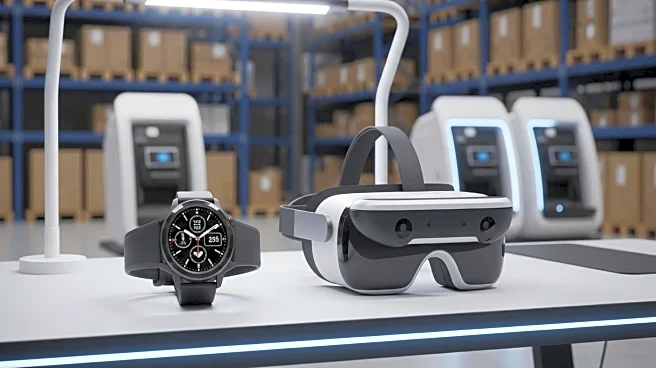What's Happening?
The logistics industry is witnessing a significant transformation with the introduction of advanced wearable technologies designed to enhance productivity and worker safety. Various companies have launched innovative products such as wearable barcode scanners, augmented reality solutions, and AI-powered exoskeletons. For instance, DHL has implemented TeamViewer Frontline Pick, a smart glasses-based solution that has increased productivity by 15% and reduced training time significantly. EPG's LYDIA Live Translation offers real-time translation capabilities in over 40 languages, facilitating seamless communication among warehouse workers. Additionally, German Bionic's Exia exoskeleton provides dynamic lift assistance, optimizing support based on real-time motion data. These wearables are designed to reduce physical strain and improve operational efficiency in warehouses, manufacturing plants, and retail stores.
Why It's Important?
The adoption of wearable technology in warehouses is crucial for improving worker safety and operational efficiency. By reducing physical strain and enhancing communication, these devices can lead to fewer workplace injuries and higher productivity. Companies stand to benefit from reduced training times and increased accuracy in order picking and inventory management. The integration of AI and augmented reality in these wearables represents a significant advancement in logistics technology, potentially setting new industry standards. As businesses strive to optimize their supply chain operations, these innovations could provide a competitive edge, leading to cost savings and improved service delivery.
What's Next?
As wearable technology continues to evolve, more companies are likely to adopt these solutions to enhance their logistics operations. The focus will likely be on further integrating AI and machine learning to anticipate user needs and optimize support. Companies may also explore partnerships with technology providers to customize solutions that meet specific operational requirements. Additionally, there may be increased investment in pilot projects to test the effectiveness of these wearables in different environments. Stakeholders, including logistics firms and technology developers, will need to collaborate to address challenges such as device interoperability and data security.
Beyond the Headlines
The introduction of wearable technology in logistics raises important ethical and legal considerations, particularly regarding worker privacy and data security. As these devices collect and analyze vast amounts of data, companies must ensure compliance with privacy regulations and protect sensitive information. Furthermore, the shift towards automation and AI-driven solutions may impact employment patterns, necessitating discussions on workforce adaptation and training. Long-term, these technologies could lead to a redefinition of job roles within the logistics sector, emphasizing the need for continuous learning and skill development.










